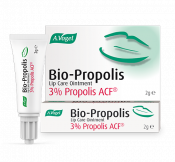An introduction to cold sore stages
During the 10-14 day healing process, your cold sore will usually go through a relatively predictable 5-stage process. Knowing which stage happens when can help you to make sure you’re doing everything you can to help it heal as quickly as possible and prevent it spreading to others.
So let’s explore the 5 stages of a cold sore.
Stage 1: Tingling
This is usually the first indication that you have a cold sore coming on. As the cold sore virus, HSV-1, travels along your nerves to your skin, it can cause a slight tingling, itching or irritation. When the virus reaches your skin it begins to replicate, furthering this irritation.
This stage occurs on days 1-2 of the outbreak.
This is the perfect stage to apply cold sore treatments – catching the cold sore as early as possible will help to reduce the severity and duration of the outbreak. Make sure to boost your vitamin C intake now, and reduce stress as much as possible to give your body the best chance of healing quickly.
Stage 2: Blisters appear
On days 2-4 of the outbreak, blisters will begin to appear on the lips, usually in the location where tingling was experienced. These usually consist of a cluster of small blisters, rather than one large one. The blisters will be fluid-filled and normally red around the outside.
Cold sore treatments may still be effective at this stage so keep applying it – just be careful not to irritate or burst the blisters.
Stage 3: Blisters burst
These fluid-filled blisters tend to burst on day 4 or 5 of the outbreak, leaving them open and sore. At this point they tend to merge into one large blister.
It is important at this stage that you do not touch the blisters as this could cause bacteria to enter and trigger a secondary infection. Picking at the sores could also make them larger!
If you do touch the blisters for any reason, make sure to wash your hands immediately afterwards to prevent the sores spreading to other parts of your body, or to other people.
Be wary of face cloths and hand towels during this stage, as these could easily come into contact with the open sore and then another part of your body, such as your eyes. Make sure you don’t share face cloths or hand towels with other people during this stage as you don’t want the virus to spread to them.
You might find it painful or difficult to apply ointment or treatment at this stage, so a cold compress may be a good idea to relieve pain. Make sure to use clean water (preferably boiled and allowed to cool) as well as a clean cloth.
However, if you can, then applying an ointment at this point can be really useful as it stops bacteria and dirt from entering the open sore.
Stage 4: Crusting
A dry scab or crust will appear over the sores on days 5-8 in order to heal them. These can crack and split, which again can be very painful. Applying cold sore treatments now may help to keep them moist and protected while they heal.
At this point, the blisters can appear yellow or brown, which can be unpleasant but is normal. Again, it is important not to pick at the blisters at this point as this will slow down the healing process – the scabs are there for a reason!
Stage 5: Scabs peel off
At some point over the next few days – usually days 8-10 – these scabs will start to flake or peel off on their own, and the skin underneath will usually be slightly red. This red skin can linger for a few more days as your skin fully heals.
At this point, St John’s Wort oil may help to prevent scarring and heal the skin quicker.
They can still be contagious at this point, so if you have to touch them for any reason, remember to wash your hands!





 Looking for our products in a store near you?
Looking for our products in a store near you?

